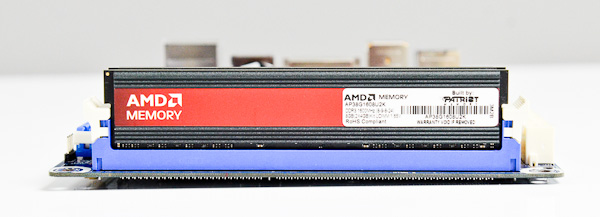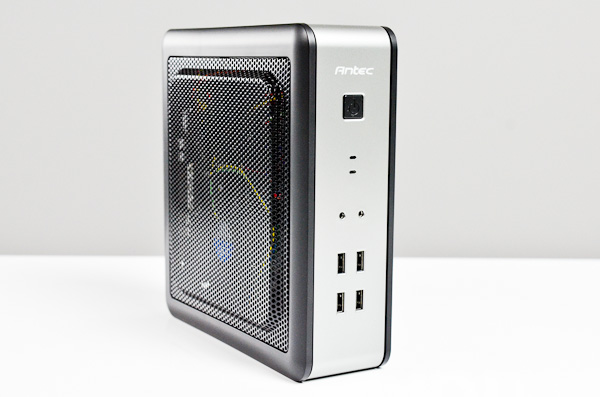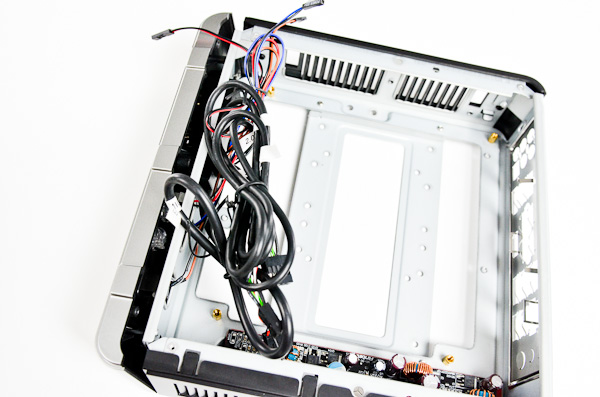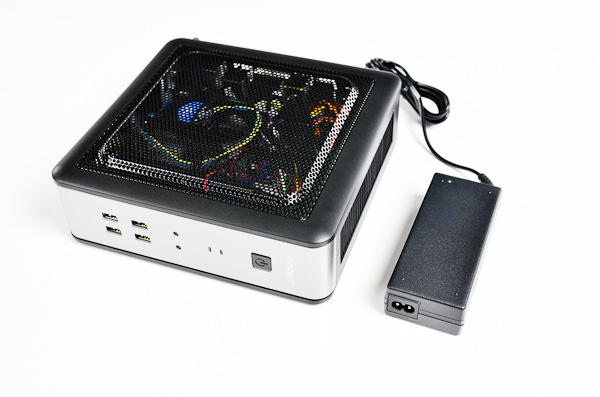Replacing my HTPC with a mini ITX System
by Anand Lal Shimpi on May 24, 2012 1:44 PM EST- Posted in
- Systems
- CPUs
- Intel
- Home Theater
- HTPC
- H77
- TheaterBlog
Free time is hard to come by these days. Since the beginning of the year I've hit Vegas, Barcelona, Santa Clara, New York, Santa Clara (again), Austin, Seattle, Chicago, Santa Clara (again) and Folsom. Before the end of June I'll add Taipei, San Francisco and Seattle again to the list. My travel schedule as of late has taken its toll on a number of things, one of which has been my ability to spend much time in the theater I built a while ago, inspired by this old AVS forum thread.
I've needed to rebuild the HTPC in there for a while. Truth be told, my most reliable HTPC was an old AMD 780G platform (Gigabyte's GA-78GM-S2H) but it lacked the HD audio bitstreaming capabilities that I was looking for. Since then I've tried adding sound cards with bitstream audio support, played with ION, experimented with Boxee, and finally moved to a Clarkdale based HTPC. All of these solutions had their quirks and for whatever reason none was quite as stable and appliance-like as the original 780G. That's usually how things go however. If it ain't broke, don't fix it right?
Times have changed however. The trend towards remote mass storage and smaller form factors applies just as well to HTPCs. Four years ago when I started thinking about the HTPC and theater I wanted a chassis that could accommodate a bunch of 1TB drives for holding all of my content. As a result, the HTPC chassis had to be much bigger than necessary. Improvements on the SoC front meant that I could almost drive the whole theater off of something Atom based, although Intel dropping the ball on serious Atom GPUs and pushing NVIDIA out of the market meant that solution wasn't going to work.
Whenever I finish a big review, especially one that I put together under an incredible time crunch, I like to take a little bit of time to do something fun. Whether it's going out for a drive or actually play one of the many games I'm constantly testing, it's a necessary part of the post-review process. It keeps me sane. After the Zenbook Prime review posted, I had a little bit of time while running data for the follow-up. I also had a stack of hardware I'd been assembling to tackle the sad state of my unstable and presently unracked HTPC. Partially out of a desire to clean the lab up a bit, I started piecing together what I hope will be the spiritual successor to my old 780G HTPC.
I've got a Promise Pegasus R6 with far too much storage driving much of my lab: benchmarks, test data, OS images, you name it. I also have a decent amount of leftover space for HT content so that became my makeshift NAS. It also meant that I didn't need room for any real storage in the HTPC, which further meant that I could go mini-ITX. Originally I expected my HTPC to remain a fixture in the theater but it turned out that I was constantly swapping components in and out as companies sent along HTPC-worthy gear that needed testing. Going mini-ITX and abandoning the idea of something large and rackmounted will make that part of my life a lot easier.
The build started with Intel's DH77DF mini-ITX board. It supports Ivy Bridge but for the time being I'm just using Intel's Pentium G850:
The Pentium G850 is a dual-core Sandy Bridge (32nm) based design with Intel's HD processor graphics (basically an HD 2000 without Quick Sync, BD 3D, Intel Insider and Clear Video HD). I underclocked the CPU to 1.6GHz from its stock 2.9GHz frequency as the decode block is doing much of the heavy lifting here. The stock retail heatsink/fan is capable and quiet enough given that the HTPC ends up tucked away in a corner of the room with audio easily drowning out any noise it would make.
The motherboard happens to have a mini-PCIe/mSATA slot on it, giving my old Intel SSD 310 mSATA drive a purpose in life. Small SSDs make for great HTPC boot drives (silent, cool running, low chance of failure right before you want to watch a movie). The mSATA interface also removes the need for running SATA and power cables, a welcome benefit when building a cramped mini-ITX system.
For memory I needed something low profile, so I ironically turned to a bundle of AMD memory I've been wanting to do something with:
If you didn't get the memo, AMD sort of officially entered the desktop memory market recently. It's a partnership between AMD and Patriot Memory at this point, where AMD selects the components and Patriot validates, distributes and supports the AMD branded DIMMs. There's only a single DRAM vendor approved today although I hear they are trying to expand the program. From AMD's perspective it's a quick way to increase top line revenues, although the memory business isn't extremely profitable. The memory works well and more importantly it's a lot more low profile than most of the high-end DIMMs I have laying around the lab, which works for my needs.
Picking the right mini-ITX chassis was a struggle as I don't believe that there many (any?) good looking mini-ITX HTPC cases on the market today. I've been pushing Antec for years but it turns out that despite the coolness of mini-ITX, motherboards and cases built around the spec just don't sell well. I really do hope this eventually changes as companies like ASUS have been taking the form factor seriously for a while now.
I ended up with Antec's ISK110, an admittedly non-HTPC-looking chassis but one that definitely gets the job done. Assembly was pretty simple once I realized that I had to unscrew and pull the front panel out a bit in order to get the motherboard installed.
The ISK110 uses an external 90W power supply. With my underclocked Pentium G850 the entire system pulls around 23W while watching a movie and peaks at 33W when installing software/doing other more CPU intensive things. Power consumption is a bit higher than I'd like but unfortunately the Intel board doesn't allow user customizable core voltages, so I'm not able to exploit the awesome benefits of voltage scaling.
The box is running Windows 7 and XBMC, while I'll rely on the PS3 for any BDs I haven't had time to rip. I haven't yet watched a full movie on it yet but it worked well in all of my tests thus far. I'm particularly excited about the portability aspect of the machine, especially since I end up moving it around a lot more than I expected to.




























56 Comments
View All Comments
Alexvrb - Sunday, May 27, 2012 - link
Does the ability to work with WHS (for backup/restore purposes, primarily) count as "super fancy"? I'm hoping Windows RT (ARM) will, but seeing as how mobile devices are its primary target, there's no guarantee.Full Ctrl - Thursday, May 24, 2012 - link
How did you connect to the Pegasus R6? Doesn't it only have thunderbolt connections?l3bowsk1 - Thursday, May 24, 2012 - link
I have a Pentium G850 in my HTPC, and it is perfect - low power envelope/heat/fan noise, but gets the job done for playing anything from Netflix and Hulu to HD rips and DVD ISOs. It's also no slouch in the gaming dept. either - mine is in a full height Silverstone case (http://goo.gl/am51j) so I could put in a GTX 560 in order to game and the G850 pushes enough frames that I can't complain. The whole system stays very cool and quiet.I've considered scaling down to a Mini-ITX, but I like the look of full-sized components - my Apple TV 1.0 and PS3 stick out like a sore thumb.
XZerg - Thursday, May 24, 2012 - link
Either they cost too much or leave a lot to be desired. All other parts are there but yet HTPC cases cost either too much or are too bulky. Seriously a nettop style case can't cost as much as many of these HTPC cases do.l3bowsk1 - Thursday, May 24, 2012 - link
Define too much - if I'm putting something under my desk or on my server shelf, I might not want to spend more than $50 on the case, but if I'm putting it front and center in my living room for all to see, a little bit more $ goes a long way.The case I linked to above for instance can usually be found for around $85 - to be fair, since I had to add a PSU, lets call the whole mess around $150, since a nettop case usually has a DC/DC PSU included.
For that money (about $100-120 more than the average entry-level nettop case), I've got a case that seamlessly blends in with my stereo equipment, is built like a brick house so has zero flex when I move it around, and is laid out so meticulously that it is only 12.5" deep and fits fine on my shelf, but still has room for several hard drives and a full-size video card. You can't say that about most cheap nettop cases.
Of course - I've got my fair share of cheap cases around the house, but they're not sitting in my entertainment center.
XZerg - Thursday, May 24, 2012 - link
That $150 exactly... a nettop can be had for $300-400 fully loaded with cpu, hdd, memory, motherboard and pre-loaded os. For HTPC, one does not really need a powerful system, just a decent cpu and gpu that can decode most media formats at a respectable fps and quality.XZerg - Thursday, May 24, 2012 - link
I meant to add that many of the nettops are the same size as most cable boxes and so they don't occupy much room either.A5 - Friday, May 25, 2012 - link
Those nettops also all run Atom or AMD's equally slow E-series CPUs.They're not really up to HTPC tasks and you can build a SB Pentium system for like $30 more that will handle everything just fine and not use that much more power.
Cygni - Thursday, May 24, 2012 - link
Would love to see an updated HTPC round-up using the Ceton Cablecard.I've been using an old Dual Core Phenom and 785G with a Ceton and it's been pretty fantastic, but I'm always on the lookout for ways to upgrade the experience.
somedude1234 - Friday, May 25, 2012 - link
After reaching my frustration limit with PS3mediaserver + the PS3 as a front end I finally bit the bullet and built a dedicated HTPC for the living room.I chose the prior generation mITX Intel board (DH67CF) and paired it with a Pentium G630 (in hindsight I may end up wishing I spent a bit more on the CPU but so far no complaints and I can always upgrade to an Ivy Bridge proc if needed).
Windows 7 boots off of a Crucial C300 64GB SSD that I already had available, I put in a single stick of 4GB DDR3 and don't anticipate I'll need to upgrade this but I can easily double it if needed.
I have auto-login and XBMC set to auto-start.
There are two things that I absolutely LOVE about the Intel Media Series motherboards:
1. Quick boot: Skips all of the unnecessary scans during POST
2. Consumer IR (CIR): I can power the system on and off via an IR remote
For a case, I chose the Wesena ITX7 in black, which looks fantastic with the rest of the AV kit. It's a little taller than it needs to be (supports a slot loading ODD that I haven't yet installed and probably won't), but does allow installation of a half-height PCIe card. I selected this case as a hedge against being disappointed in the Sandy Bridge HD2000 graphics that I get with the Pentium G630. So far I've been completely happy so no need to add a separate GPU.
With quick boot and a lean Win7 install running off of a 6 Gbps SATA SSD I can go from pressing the power button on my IR remote to the XBMC main screen in well under 10 seconds. I can be watching a movie WAY faster with this HTPC than I could with my PS3.
Finally, I'm using a 120W "pico" style PSU, at idle the system draws 15W and with 2 instances of CPUburn + FurMark I can barely crack 50W of power draw.
The total system was a bit pricey but it's blazing fast and expandable.
Couldn't be happier.